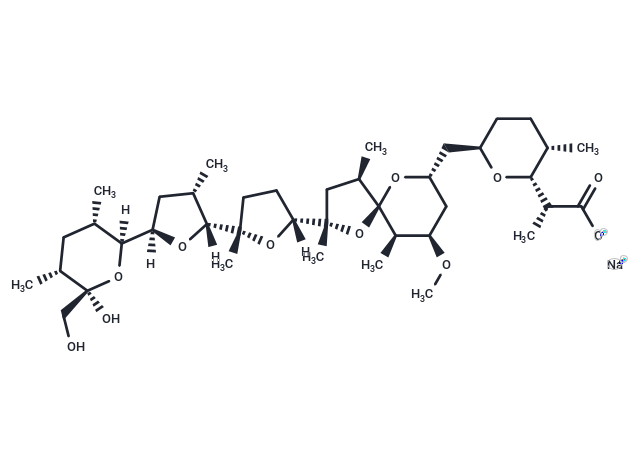Shopping Cart
- Remove All

Your shopping cart is currently empty


| Pack Size | Price | Availability | Quantity |
|---|---|---|---|
| 1 mg | $31 | In Stock | |
| 5 mg | $72 | In Stock | |
| 10 mg | $122 | In Stock | |
| 25 mg | $179 | In Stock | |
| 50 mg | $239 | In Stock | |
| 100 mg | $372 | In Stock | |
| 500 mg | $869 | In Stock |
| Description | Nigericin sodium salt is an antibiotic, an NLRP3 activator, and a cationic ion carrier. Nigericin sodium triggers the activation of the NALP3 inflammasome, which inhibits Golgi function and suppresses the growth of Gram-positive bacteria. |
| In vitro | METHODS: Triple-negative breast cancer cells MDA-MB-231 and 4T1 were treated with Nigericin sodium (0.25-20 μg/mL) for 24 h. The cell viability of the cells was detected by the MTS. RESULTS: Nigericin sodium dose-dependently inhibited the cell viability of MDA-MB-231 and 4T1 cells with IC50 of 2.881 μM and 2.505 μM, respectively. [1] METHODS: Human lung cancer cells H460 were treated with Nigericin sodium (1 μM) for 24-48 h. Cell migration and invasion were detected by Transwell. RESULTS: Nigericin sodium significantly inhibited the migration and invasion of H460 cells. [2] |
| In vivo | METHODS: To detect anti-tumor activity in vivo, Nigericin sodium (2 mg/kg, subcutaneous injection every two days) and anti-PD-1 (250 μg/mouse, intraperitoneal injection once a week) were administered to BALB/c mice bearing triple-negative mammary adenocarcinoma tumor 4T1 for two weeks. RESULTS: PD-1 antibody alone did not show significant antitumor effects, while Nigericin sodium showed moderate antitumor effects.The combination of Nigericin sodium and anti-PD-1 almost completely inhibited tumor growth. [1] METHODS: To investigate the effects of aging on inflammatory vesicle function, Nigericin sodium (0.005 mg/g, 250 μL) was administered as a single intraperitoneal injection once daily for seven days to influenza virus-infected BALB/c mice. RESULTS: Treatment with Nigericin sodium during influenza infection increased IL-1β production, increased capase-1 activity, and reduced morbidity and mortality in aged mice. During influenza virus infection, NLRP3 inflammatory vesicle activity is impaired in aged mice, and Nigericin sodium treatment rescues NLRP3 in aged hosts.[3] |
| Molecular Weight | 746.94 |
| Formula | C40H67NaO11 |
| Cas No. | 28643-80-3 |
| Storage | |Powder: -20°C for 3 years | In solvent: -80°C for 1 year | ||||||||||||||||||||||||||||||||||||||||
| Solubility Information | DMSO: 3 mg/mL (4.02 mM), Sonication is recommended. Methanol: 122 mg/mL (163.33 mM) Ethanol: 50 mg/mL (66.94 mM), Sonication is recommended. | ||||||||||||||||||||||||||||||||||||||||
Solution Preparation Table | |||||||||||||||||||||||||||||||||||||||||
Methanol/DMSO
Methanol
| |||||||||||||||||||||||||||||||||||||||||

Copyright © 2015-2024 TargetMol Chemicals Inc. All Rights Reserved.